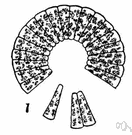diatom
Also found in: Thesaurus, Medical, Encyclopedia, Wikipedia.
Related to diatom: diatomaceous earth
di·a·tom
(dī′ə-tŏm′)n.
Any of various microscopic one-celled or colonial heterokonts of the class Bacillariophyceae that are photosynthetic, have a silica cell wall made up of two interlocking parts, and form an important component of phytoplankton.
[New Latin diatoma, from Greek diatomos, cut in half, from diatemnein, to cut in half : dia-, dia- + temnein, to cut; see tem- in Indo-European roots.]
American Heritage® Dictionary of the English Language, Fifth Edition. Copyright © 2016 by Houghton Mifflin Harcourt Publishing Company. Published by Houghton Mifflin Harcourt Publishing Company. All rights reserved.
diatom
(ˈdaɪətəm; -ˌtɒm)n
(Microbiology) any microscopic unicellular alga of the phylum Bacillariophyta, occurring in marine or fresh water singly or in colonies, each cell having a cell wall made of two halves and impregnated with silica. See also diatomite
[C19: from New Latin Diatoma (genus name), from Greek diatomos cut in two, from diatemnein to cut through, from dia- + temnein to cut]
Collins English Dictionary – Complete and Unabridged, 12th Edition 2014 © HarperCollins Publishers 1991, 1994, 1998, 2000, 2003, 2006, 2007, 2009, 2011, 2014
di•a•tom
(ˈdaɪ ə təm, -ˌtɒm)n.
any of numerous mostly marine algae of the class Bacillariophyceae (phylum Chrysophyta), each one-celled alga being enclosed in an intricately patterned double shell of silica, one shell fitting over the other like a box lid.
[1835–45; < New Latin Diatoma orig. a genus name, feminine n. based on Greek diátomos cut in two. See dia-, -tome]
Random House Kernerman Webster's College Dictionary, © 2010 K Dictionaries Ltd. Copyright 2005, 1997, 1991 by Random House, Inc. All rights reserved.
di·a·tom
(dī′ə-tŏm′) Any of various microscopic one-celled algae that live in water, have hard shells composed mostly of silica, and often live in colonies. Diatom shells are made of two symmetrical parts called valves.
diatomaceous (dī′ə-tə-mā′shəs) adjective
The American Heritage® Student Science Dictionary, Second Edition. Copyright © 2014 by Houghton Mifflin Harcourt Publishing Company. Published by Houghton Mifflin Harcourt Publishing Company. All rights reserved.
ThesaurusAntonymsRelated WordsSynonymsLegend:
Switch to new thesaurus
| Noun | 1. |  diatom - microscopic unicellular marine or freshwater colonial alga having cell walls impregnated with silica diatom - microscopic unicellular marine or freshwater colonial alga having cell walls impregnated with silicaphytoplankton - photosynthetic or plant constituent of plankton; mainly unicellular algae alga, algae - primitive chlorophyll-containing mainly aquatic eukaryotic organisms lacking true stems and roots and leaves Bacillariophyceae, class Bacillariophyceae, class Diatomophyceae, Diatomophyceae - marine and freshwater eukaryotic algae: diatoms |
Based on WordNet 3.0, Farlex clipart collection. © 2003-2012 Princeton University, Farlex Inc.